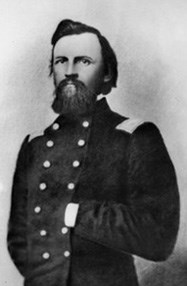
Taken from The Wisconsin Magazine of History 4 (1920) Hans Christian Heg was one of four children born at Lier, near Drammen, Norway, on December 21, 1829. The Heg family immigrated to America in 1840 and settled on the shores of Lake Muskego, Wisconsin. For some years Muskego had the distinction of being the destination point for the majority of Norwegian immigrants to America, and the Heg family barn became the gathering point for many of the new arrivals. Wisconsin Governor Randall appointed Heg a colonel on October 1, 1861, and assigned him the task of raising a Scandinavian Brigade in response to the pending war that faced their adopted country. Recent immigration from Norway, Sweden, and Denmark provided more than 75,000 able bodied citizens in 1861. Heg's recruiting efforts included an editorial in the Emigranten, Oct. 5, 1861. In this call, Heg asked for a thousand men—Norwegians, Swedes, and Danes. He said, "The officers of the regiment will be men who speak the Scandinavian languages. Thus an opportunity to enter the service is afforded those Scandinavians who do not yet speak English." From this call, Norwegian volunteers from Wisconsin, Iowa, Minnesota, and Illinois formed the Fifteenth Wisconsin Volunteer Infantry. Heg was a gifted volunteer officer in the Union Army, his first military command being the Fifteenth. Notable engagements of the Fifteenth Wisconsin included Island No. 10, the Battle of Perryville, the Battle of Stones River, the Tullahoma Campaign, the Battle of Chickamauga, the Siege of Chattanooga (Missionary Ridge), the relief of Knoxville, Rocky Face Ridge and Dalton, the Battle of Resaca, and the Atlanta Campaign. Colonel Heg's final battle was at Chickamauga on September 19, 1863. The Fifteenth Wisconsin was fully exposed to enemy fire during repeated attacks and counter attacks throughout the day. While actively rallying his brigade from one of these repulses, Heg received a mortal wound, of which he succumbed to in a nearby field hospital. A triangular pyramid monument of eight inch shells, ten feet in height, marks the spot where Colonel Heg was mortally wounded (seven more of these pyramids can be located throughout Chickamauga Battlefield). The monument can be found in Viniard Field beside the LaFayette Road at Tour Stop #5. Bibliography Blegen, Theodore C. "Colonel Hans Christian Heg." The Wisconsin Magazine of History 4 (1920-1921): 139-165. Dyer, Frederick H. A Compendium of the War of the Rebellion, Vol. III. New York: Thomas Yoseloff, 1959. Cozzens, Peter. This Terrible Sound: The Battle of Chickamauga. Chicago: University of Illinois Press, 1996. |
Last updated: April 14, 2015
